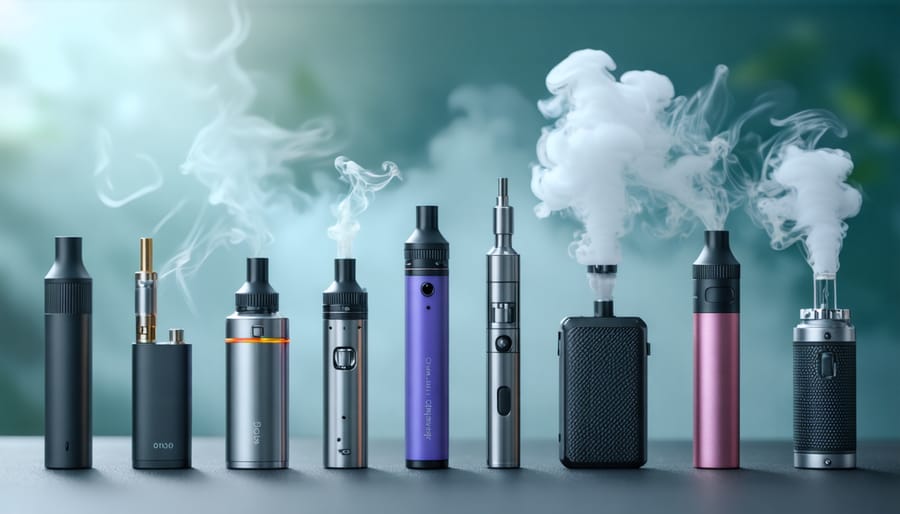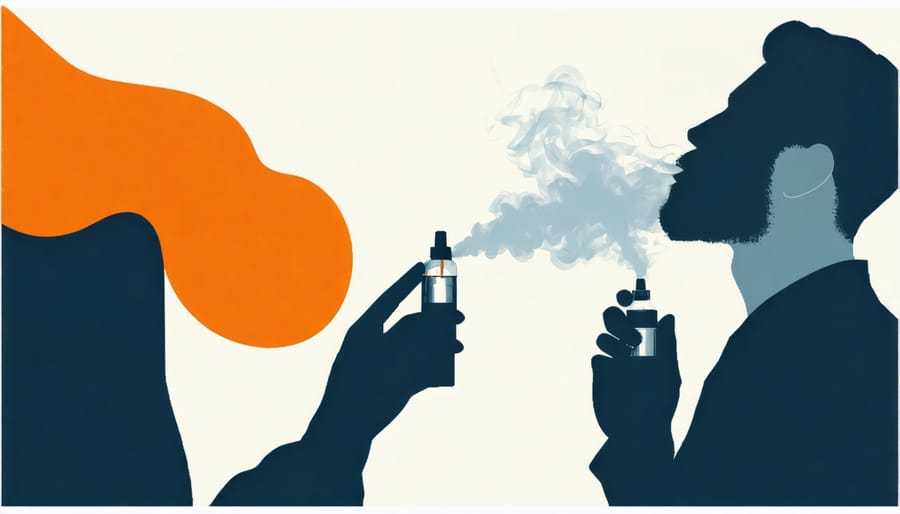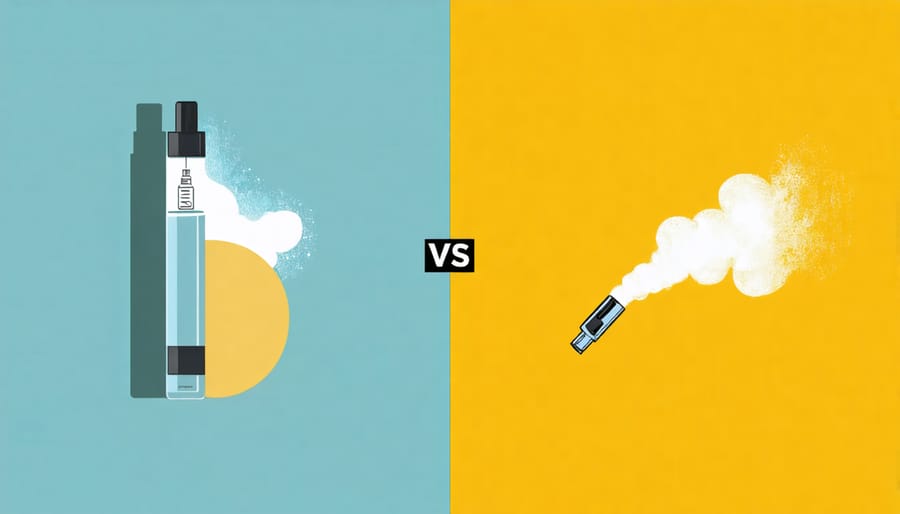The evolution of vaping has transformed addiction recovery approaches, offering alternatives for those seeking to overcome substance dependencies. With an expanding variety of options, from traditional flavors to refreshing choices like fresh watermelon ice, vaping has emerged as a potential tool in harm reduction strategies. This article explores the complex relationship between vaping and addiction recovery, examining both its potential benefits and challenges while considering the perspectives of healthcare professionals, personal experiences, and alternative approaches.
The Rise of Vaping in Recent Years
Vaping: A Popular Trend
Vaping has surged in popularity across various demographics, offering an alternative to traditional smoking. Its appeal often lies in the perceived reduced health risks and the wide range of flavors available. Many view vaping as a trendy lifestyle choice, contributing to its growth. For those in addiction recovery, vaping can present a tempting option, especially as a harm reduction tool. However, it’s crucial to approach vaping with caution and understanding, acknowledging both the potential benefits and risks. Balancing these aspects can empower individuals in their recovery journey, ensuring decisions are informed and supportive of long-term health goals.
Health Perspectives on Vaping

Vaping has become a topic of significant debate in health circles, particularly concerning addiction recovery. While some experts view vaping as a potentially safer alternative to smoking, helping individuals reduce tobacco harm, others caution that it is not without risks. Vaping products can contain nicotine, which remains addictive. According to Canadian health specialists, vaping should not be seen as a risk-free substitute. For those in recovery, understanding these nuances is crucial. It’s essential to explore both the potential benefits and the drawbacks while considering other cessation aids and recovery options. Always seek guidance from healthcare professionals tailored to personal needs.
Vaping as a Tool for Addiction Recovery
Potential Benefits in Recovery
For individuals in addiction recovery, finding effective harm reduction strategies is crucial. Vaping might offer potential benefits as a less harmful alternative to traditional smoking. Nicotine replacement through vaping can support those who are overcoming addiction by managing cravings without the more harmful effects of tobacco smoke. Some experts argue that vaping can serve as a transitional tool, gradually lowering nicotine intake while reducing exposure to the carcinogens found in cigarettes. This strategy may be particularly beneficial in helping individuals who struggle with smoking addiction within their broader recovery journey.
Moreover, adopting vaping in place of smoking could potentially lead to improved respiratory health and a decreased risk of smoking-related illnesses, which can be empowering for many on their path to recovery. It’s also important to note that this approach should ideally be part of a comprehensive support plan, including counseling and community support, to maximize its effectiveness and ensure it aligns with individual recovery goals.

Risks and Concerns
While vaping is often considered a less harmful alternative to smoking, it’s important to acknowledge the potential risks and concerns, especially in the context of addiction recovery. One major issue is the possibility of substituting one dependency for another. Vaping often involves nicotine, which is highly addictive and could inadvertently hinder recovery by maintaining a dependency cycle. Moreover, the health implications of vaping are still being studied, with emerging evidence suggesting that it may not be entirely risk-free. It can potentially harm lung health and contribute to cardiovascular issues.
For those in recovery, managing stress and coping mechanisms are crucial, and reliance on vaping may provide a temporary solution but fail to address underlying issues. It’s also worth considering that the availability and social acceptance of vaping might lead to increased usage and dependency, counteracting recovery goals. Reflecting on these potential risks and engaging in informed discussions with healthcare professionals can support healthier recovery choices. Seeking alternative methods such as mindfulness or therapy could provide more sustainable pathways to recovery without the health risks associated with vaping.
Expert Opinions
Addiction specialists and healthcare professionals offer diverse views on vaping in recovery. Some experts see vaping as a less harmful alternative to smoking, potentially aiding those recovering from nicotine addiction by providing a safer option. Others caution that vaping might not support long-term recovery, highlighting risks of sustaining nicotine dependency or replacing one addiction with another. From a Canadian perspective, balancing potential benefits with risks is crucial, especially considering the impact on family. Experts suggest integrating vaping cautiously into a comprehensive recovery plan that includes therapy, support groups, and lifestyle changes to enhance recovery outcomes.
Personal Stories and Experiences
Success Stories
Emily, a 34-year-old from Toronto, had struggled with addiction to cigarettes and alcohol for years. She recounts her journey towards recovery, sharing how vaping became a key component. Initially skeptical, Emily was introduced to vaping by a support group member. For her, vaping offered a sense of control, allowing her to manage nicotine cravings without the harmful effects of tar and other chemicals found in traditional cigarettes. As she adapted, Emily found it easier to engage in therapy while maintaining her routine, strengthening her resolve to quit completely.
Similarly, David from Vancouver, who had been battling substance use for over a decade, turned to vaping as part of a harm reduction strategy. He shared that it provided a stepping stone, helping to minimize withdrawal symptoms and reduce anxiety triggers. Both Emily and David emphasize that while vaping wasn’t a cure-all, it played a vital role in weaving together their path to recovery, complemented by professional guidance and strong community support.
Challenges and Setbacks
Incorporating vaping into addiction recovery plans can come with its own set of challenges. Many individuals have found themselves navigating a delicate balance between reducing harm and inadvertently forming another dependency. For some, the transition from traditional cigarettes to vaping seemed promising, yet the addictive nature of nicotine still posed hurdles. A key concern is the potential for vaping to act as a substitute rather than a stepping stone away from nicotine use. Individuals often grapple with managing triggers associated with inhalation habits, which can sometimes lead them back to more harmful substances.
Support networks have also expressed apprehension about vaping, worrying it might derail progress. Misinformation and inconsistent research findings can create confusion for people trying to make informed decisions. Experts recommend approaching vaping with caution, ensuring it fits within a comprehensive recovery strategy. This involves setting clear goals and having open discussions with healthcare professionals to evaluate both the benefits and the risks for each individual’s recovery journey. Balancing these factors remains a pivotal challenge for many in recovery.

Alternatives to Vaping in Recovery
Behavioral Therapies
Behavioral therapies play a critical role in addiction recovery, emphasizing sustainable change through modified behavior patterns and thought processes. These therapies, such as Cognitive Behavioral Therapy (CBT) and contingency management, are designed to address the root causes of dependency while crafting healthier coping mechanisms. For those struggling with vaping as part of their journey to quit smoking or overcome other addictions, these therapies offer a supportive framework for identifying triggers and developing strategies to overcome them. Behavioral therapies can also help build resilience, reduce cravings, and improve overall mental health, providing much-needed support for individuals seeking to regain control of their lives. For personalized guidance, consider exploring additional resources on how to offer help in recovery.
Natural and Holistic Approaches
Exploring natural and holistic approaches can be a meaningful addition to addiction recovery journeys. These methods focus on healing the mind, body, and spirit in a balanced way. Meditation and mindfulness, for instance, offer calming practices that help individuals manage stress and triggers associated with addiction. Engaging in activities like yoga or tai chi can enhance physical and mental well-being, promoting a sense of inner peace. Nutritional therapy, emphasizing whole foods and balanced diets, supports the body’s recovery process and boosts energy levels. Herbal supplements such as milk thistle or valerian root may also be considered, though it’s important to consult with a healthcare professional before use. These holistic strategies, accompanied by support networks, empower individuals to create healthier lifestyles while respecting personal recovery goals.
Conclusion
As we draw together the insights explored throughout this article, it’s clear that vaping occupies a complex role in the landscape of addiction recovery. While some individuals have found it a useful tool for harm reduction, helping them transition from more harmful substances, others caution against the risks of substituting one addiction for another. It’s crucial to remember that everyone’s journey is unique, and what works for one person might not suit another. Encouraging informed decision-making involves weighing the potential benefits of vaping against its risks and considering the wide range of recovery options available.
Support networks and healthcare professionals can play a pivotal role in this process, offering guidance and perspective grounded in expertise and compassion. If you’re considering vaping as part of your recovery effort, engaging in open conversations with these networks can be invaluable. Remember, you’re not alone on this journey; support is available, be it through professional counseling, 12-step programs, or other holistic approaches that align with your values and needs. Informed choices, supported by evidence and empathy, empower you to take control of your recovery path, leading towards a healthier, more fulfilling life.

